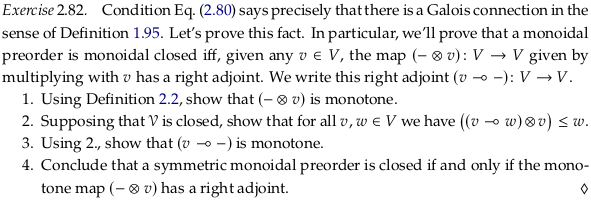Exercise 2.82#

For 1. let’s define:
Given \(x_1 \leq y_1\) where \(x_1, y_1 \in \mathcal{V}\), we must show that:
If we set:
Then we have by reflexivity:
And can use (a) (monotonicity) in Definition 2.2. to conclude:
For 2. let’s define:
By reflexivity:
Using the fact that \(\mathcal{V}\) is closed we have:
Which is what we intended to show. See nearly the same answer in part (c) of Proposition 2.87.
For 3. let’s define:
Given \(x \leq y\) where \(x, y \in \mathcal{V}\), we must show that:
Starting with:
Including the result from 2. with \(x\) replacing \(w\):
Then using the fact that \(\mathcal{V}\) is closed, we have what we intended to show:
For 4., notice that in 2. and 3. we only showed the reverse; that being monoidal closed
implies that (v ⊸ -) is a monotone map. A quick review of Definition 1.95 makes it clear that this
means (v ⊸ -) is a right adjoint however, and this definition has the same structure as Definition
2.79.